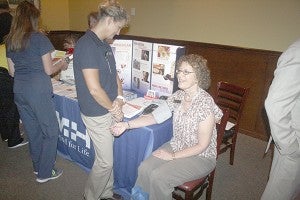Health care for a longer life
Published 7:00 am Saturday, June 28, 2014

PRESSURE CHECK: Slidell Memorial Hospital staff offered blood pressure checks during Friday’s Greater Picayune Area Chamber of Commerce Morning Call Breakfast.
Photo by Jeremy Pittari
Health care is advancing with each passing year, but while that care appears help people live longer they don’t necessarily live healthier.
This was the message shared with attendees at Friday’s Greater Picayune Area Chamber of Commerce Morning Call Breakfast by Slidell Memorial Hospital CEO Bill Davis.
It’s not health care that is preventing people from living healthy, it’s the choices people make in their diet and lifestyle, Davis said. He used an automobile extended warranty as an example; taking care of the human body will provide years of worry free operation.
Due to poor diet and lifestyle choices patients are now living longer even with chronic illnesses.
To help combat that problem and another problem involving patients returning to the hospital within a month, the hospital started a Continuing Care Demonstration Project, where volunteering patients allow a health professional to enter their home and provide pointers on what foods are good and bad, among other tips to break the cycle of heart diseases such as chronic obstructive pulmonary disease and chronic heart failure.
Before starting this program, 22 percent of patients suffering from COPD and CHF were readmitted 30 days after being discharged, Davis said. Within five months of conducting the program, the number of participating patients being readmitted dropped to one percent. However, only 20 percent of the volunteers qualified to participate in the program.
Davis went over some other statistics during his presentation, including the fact that 17 percent of the people admitted to Slidell Memorial Hospital are from Pearl River County. Davis suggested seeking care as close to home as possible because it provides easy access to friends and family, which helps in the healing process.
“Once you lose hope it’s hard to continue the healing process,” Davis said.
After Hurricane Katrina the hospital experienced a 30 percent increase in patients coming to their emergency room. Recently the hospital opened a new wing to the ER and cardiology. Since opening the new wing ER admissions increased another 18 percent, Davis said.
Turnover in the medical field has been high recently, a trend Davis attributes to the difficult nature of treating today’s sicker population.
“Nurses and doctors are bailing out like crazy right now,” Davis said.
However, the hospital has 137 physicians on staff to help care for a patient’s medical needs.
The hospital is one of a few with the capability to treat 98 percent of all cancers, Davis said.
Currently research is ongoing at other hospitals to cover the remaining two percent.
As a final note, Davis said that early detection of health problems is the key to a quicker recovery.



